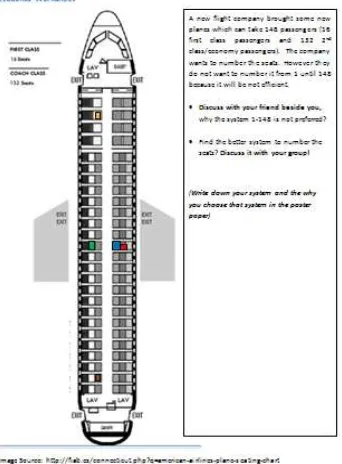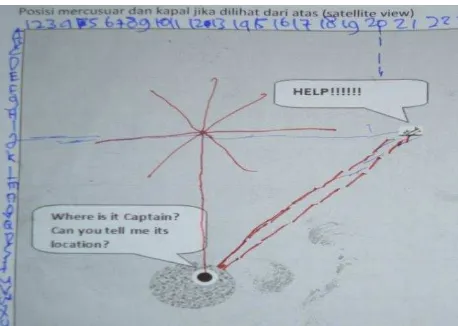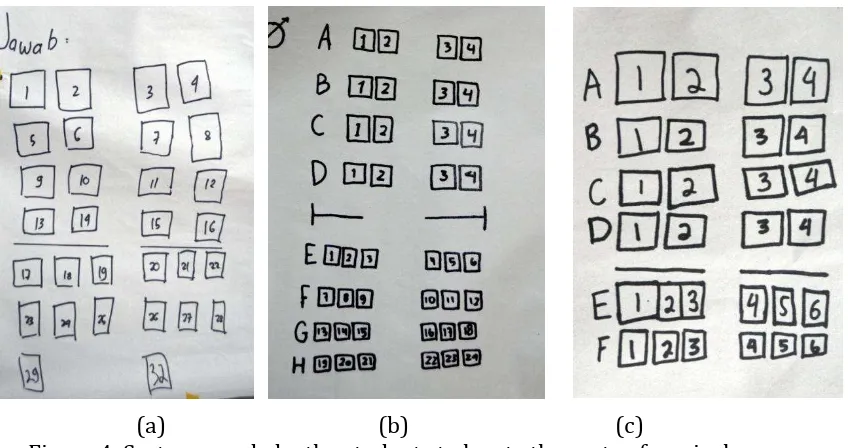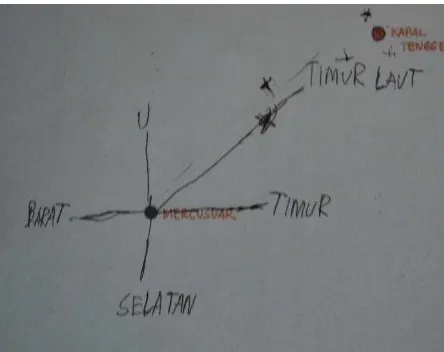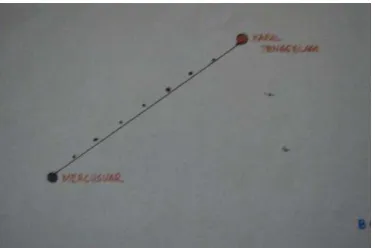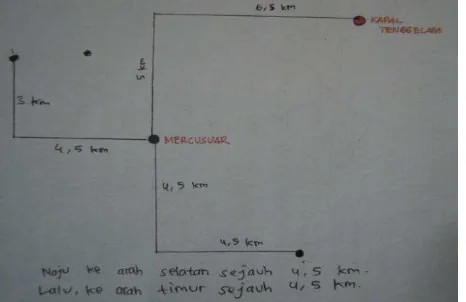104
HOW CAN THE STUDENTS OF 5TH GRADE MAKE UP A SYSTEM TO
LOCATE AN OBJECT: Level of Child’s Developmental Thinking Of
Locate A Point
Evangelista L.W. Palupi1, Zulkardi2, Darmawijoyo2, Meike J. Abels3
State University of Surabaya1, Sriwijaya University2, Utrecht University3
[email protected], [email protected],
[email protected], [email protected]
Abstract
Coordinate (location) system often to be seen as an easy (mathematics) topic. Teachers often think that students will automatically understand about it as long as the rule and notation are given. Yet in fact, there are still students who make a mistake and cannot solve the problem related to it correctly.
Teach the rule of the Cartesian coordinate system is too formal for the students and less meaningful. Directly teach the formal level of coordinate system does not guarantee that the students will be able to relate it to the real world. It cannot guarantee that the students are able to use it or make up a system to locate objects in the different situation beyond the situation of the Cartesian coordinate system.
In order to know how the children of 5th grade can make up a system to locate an object precisely, two activities based on realistic mathematics (so called Pendidikan Matematika Realistik Indonesia/ PMRI) approach are designed. The first activity is making a system to locate/number the seats in an airplane and the second one is making a system to locate a sunken ship. So that, the purpose of this study is to contribute in making a local theory in coordinate location system topic.
Design research is used as the research approach and methodology of this study. The discussion about how the students (5th graders) locate an object in a plane also will be related to the level of child s developmental thinking of locate a point which is proposed by Piaget et.al. (1960). These activities are part of the larger learning sequence which is designed to help the students to understand about coordinate systems.
Keyword: Realistic Mathematics (PMRI), Design Research, Coordinate (location) system
The coordinate system topic is started to be taught at 6th grade of elementary school
105 rule and the notation without know what it is and why it should be like that. So instead of understanding the coordinate systems, the students only memorize the coordinate system.
As an effect of the direct and formal teaching of the coordinate system, students only know particular kind of coordinate system. The students only know about the formal/ abstract level of map coordinate system and Cartesian coordinate system. Hence, it is not meaningful for them. Although it often to be seen as easy topic, there are students who still make a mistake in solving the problem related to the coordinate system. Reverse the x and y, ignore the origin (Sarama et.al., 2003), and only see one parameter x or y (Blades and Spencer, 2001) are common mistake that happen in solving the problem involves the Cartesian coordinate system.
Moreover, know the formal abstract level of the coordinate systems does not mean they understand it and able to use it in the real situation. If the students are given the more open problem beyond the situation of those two formal coordinate systems, they face the difficulty to solve it. They cannot directly apply the coordinate system that they learnt into the real situation.
Furthermore, directly telling the students about the coordinate system gives us (the teachers and researchers no chance to know the students developmental thinking of locating a point. Piaget et.al. 6 stated that there are five levels of child s developmental thinking of locate a point. 1st level: students will use visual estimates to locate the point. 2nd level: they will start to use measurement tool, but only one measurement, maybe from the vertex or corner. 3rd level: students start to recognize that they need two measurements (not yet perpendicular). 4th level: students successfully use 2 perpendicular measurements (but still trial and error). And 5th level: students construct an interiorized mathematics coordinate system. They finally realize the logical necessity to take both dimensions.
In order to know how the children of 5th grade (10-11 year old) can make up a system
to locate an object precisely, in both row-column arrangement and in a plane, two activities on realistic mathematics approach are designed. The first activity is making a system to locate/number the seats in an airplane and the second one is making a system to locate a sunken ship. The discussion about how the students locate an object in a plane also will be related to the level of child s developmental thinking of locate a point which is proposed by Piaget et.al. (1960). These activities are part of the larger learning sequence which is designed to help the students understand about coordinate system itself.
Research Question and Research Aim
My interest is to know how the students of 5th grade can understand the coordinate
systems. Thus I designed a learning sequence consists of 6 activity about coordinate system. However in this study I will only focus on two activities which are about make up a system to locate a point. The analysis will be focused on how the children 10- year old can make up a system and focused on the children s level of developmental thinking of locate a point.
106 Research Methodology
The purpose of the present study is to contribute to an empirically grounded instructional theory for the coordinate system topic. A learning sequence and its hypothetical learning trajectory (HLT) about understanding the coordinate system are designed, tested and improved. Two activities addressed in this study are part of that learning sequence. Because designing and testing the HLT in the classroom setting is considered as the crucial part of this study. Hence, design research is used as the research approach and methodology of this study. The initial target group is 6th
graders. But due to national examinations issue, we change the target group to the students in the grade five (10-11 year old) which is still appropriate because they had learnt the needed prior knowledge.
There are three phases in the design research (Gravemeijer and Cobb, 2006). The activities (HLT) which are designed in the preparation and design phase (phase 1) are tested in 8 students of 5th grade (phase 2: teaching experiment phase, cycle 1).
The data collected from the first cycle is used as base to improve the HLT. Later, the improved HLT/ activities are tested in the real classroom (phase 2: teaching experiment phase, cycle 2). All data collected from the cycle 2 are analyzed (phase 3: retrospective analysis). The details of each phase and the findings will be described on main section.
MAIN SECTION
In this section, we will describe the three phase of the design research (includes the finding). Those three phases are: preparation and design phase, teaching experiment (consists of cycle 1 and cycle 2), and retrospective analysis of both activities.
Preparation and Design Phase
In this phase, we designed two activities about making up the system to locate an object. Learning goals are determined, students thinking and answer are conjectured, and the role of the teacher is also described in hypothetical learning trajectory (HLT).
The first activity is making up a system to locate or to number the seats on an airplane. The aim of this activity is to give a chance for the students experiencing in making up a system to organize a thing, in this case is the plane s seats. Make them aware of row and column and make them understand what a good system is.
107 Figure 1. Seatmap of an airplane
The second activity is locating the sunken ship from the lighthouse (Figure 2). Different from the first activity, in this activity students are asked to locate an object in a plane without grid or row-column. They are only given the map, compass direction, and the line that represent 1 km distance.
Figure 2. The map of the sunken ship
Teaching experiment: Cycle 1 (8 participants)
The first activity (make up a system to locate the seats of the plane) is totally messed up. The students can understand why numbering the seat from 1 to 148 is not preferable by the owner. Yet when they are asked to make u system to locate the seats precisely and effectively they seem to have no idea. The students cannot make up a system at all. Although they familiar with the plane (this is different from what some supervisors thought that students are not familiar with airplane) and they know that the seats are arranged in the lines, they cannot connected it.
108 understanding how a system used to number the seats on the cinema works. From that activity, the students become aware of the use of row and column arrangement. They also learnt that a good system should can be used to locate an object precisely and uniquely (do not lead to another location). It helps the students to make up a system for the problem in the first activity (numbering the seats of an airplane). So, in the cycle , we decide to give the cinema activity first, before the airplane activity. in addition, we also decide to make the problem more open. So in the second cycle we plan to free the children in make up the systems. They can also include the number the seat from 1-148. And about which system is more effective will be brought into classroom discussion.
In the second activity, the students are asked to locate the sunken ship. At first the students answers that occur is the same like we conjecture, only locate it using the compass direction or using the distance. Surprisingly, after they realized that locate the ship only using compass direction (it is located in the north east of the lighthouse) is not precise enough, they come up with the idea of using the similar system like they used airplane activity Figure . This is beyond the prediction.
Figure 3. System made by the student to locate the sunken ship
Furthermore, although there are some students who used the similar system, they got the different location. These answers are compared and from here, the students notice that the location is different because they use the different starting point (up-corner, bottom-(up-corner, and lighthouse). In addition, the also notice that the different distance of the point in the axis makes them to get the different location. Those noticing will be added in HLT.
Teaching experiment: Cycle 2 (real classroom experiment: 34 participants) The improved HLT are tested in the real classroom which involves 34 students of 5th
grade. In this cycle, teacher implements the both activities in different day continuously. The students are divided into some groups of 4 and group of 5. Before we give the airplane problem, we give the cinema activity. they learn to understand how a system used in cinema works. From that, later they are asked to make up a system to locate or to number the seats of an airplane.
109 and the column by 1 to 4, and 1 to 6. They automatically separate the seats into two parts (business and economy). There is also group who make the system by numbering it from 1 to 148 or numbering the row with alphabet but still numbering each seat with number from 1 to 148. Even there is a group who number it as A11 which means it is the seat in the block A, the first row and the first seat. These systems are presented and compared. The students give their opinion of each system and they agree that the most effective system is to number the seat with alphabet and number. And numbering the seat from 1 to `148 need more time to find the seat with the certain number.
Many variation of answer occurs in the third activity. There are some conjecture which happen in the class. Students tend to use the given help which is compass direction and distance. However at first the students only locate the sunken ship using the compass direction. For example, the location of the sunken ship is in the north-east of the light house. However after the teacher points some locations which are also in the same direction (north-east) the students start to think that only locating the ship by using compass direction is not enough. This is also the same for using the distance (ex. 8km to north-east). In the end, surprisingly, there are some groups who able to make the system to locate the sunken ship precisely. They can locate the sunken ship precisely by combining angle, compass direction and distance. They said that the location of the sunken ship is in the 1350 to the north-east, 8 km from the lighthouse. There are also students find the location of the sunken ship by measuring the distance to the right and to the north from the lighthouse as origin.
Retrospective analysis
Based on the data collected in the second cycle, we can see that the students come up with various answer/ systems.
For the first activity which is make up a system to locate a seat on airplane, students come up with these three answers (Figure.4).
(a) (b) (c)
Figure 4. Systems made by the students to locate the seats of an airplane
110 the row-column arrangement. This system is not wrong. By numbering the seats from 1 to 148 we still can locate the seat precisely. However it less effective and consumes time. This idea is what we hope the students to understand. So in the discussion, the children will decide by themselves whether this system is a good system or not.
The Figure (4b) shows that this group differentiates the system of the business class and economy class. they represent the row with the alphabets and the column with umber. Although for the economy class, they number it from , , , … . Here the students start to notice the row and column. But because the number of the columns are different between the business and economy class, they decided to numbering the column of the business seat and numbering one by one for the economy class.
Figure (4c) shows us the more sophisticated system. the students represent the row with alphabet and the column with number 1 to 4 (business seat) and 1 to 6 (for the economy class). Here they make up the system by consider two parameters, row and column.
While from the second activity which is locating the sunken ship from the lighthouse, we can see that students have the different level of developmental thinking in locating an object/ point.
Many variation of answer occurs. There are some conjectures which happen in the class. Students tend to use the given help which is compass direction and distance. However at first the students only locate the sunken ship using the compass direction (Figure 5). for example, the location of the sunken ship is in the north-east of the light house. However after the teacher points some locations which are also in the same direction (north-east) the students start to think that only locating the ship by using compass direction is not enough.
Figure 5. Students locate the sunken ship by only consider the direction
There are also groups who locate the sunken ship by only considering the distance. They said that the location of the sunken ship is about 8 km from the light house. But when the teacher points another location which is also 8 km from the light house, the students realize that only consider compass direction or distance alone is not enough.
111 to get a more precise location/ system. In other word, they consider two parameters although is not perpendicular yet.
Figure 6. Students locate the ship by considering the distance and the direction
Actually, locating the sunken ship by considering the direction and distance is precise enough. But when the teacher asks them to tell the location of some points which are 8 km from the lighthouse but not exactly in the north-east (near the north east) they start to think about more sophisticated system.
There is also a group who come up with the idea of angle. They locate the sunken ship by considering its distance from the lighthouse, the direction and the angle (Figure 7). So they claim that the location of the sunken ship is 1350 to the north-east and around 8 km from the lighthouse.
Figure 7. Students make up a system to locate a sunken ship by involving angle
There are groups who come up with the idea walk straight/north then turn right/east Figure . So these students said that the location of the sunken ship is around 5 km to the north and . km to the right or go straight to the north as far as
112 Figure 8. Students make up a system to locate the sunken ship by considering
distance, direction and two dimensions measurement (north and east).
This shows that the students locate the point or object by considering two parameters (distance and direction) and considering two perpendicular axis (direction north and east).
So although there are students who are still only consider one parameter, but there are also students who show the improvement/ development of their thinking in locating a point. From only considering one parameter, two parameters not perpendicular, till considering two perpendicular parameters. In other words, given the designed activity and with guidance from the teacher, the students show a lot improvement in making a sophisticated system to locate and object precisely.
CONCLUSION
The fact that the students able to make up the system to locate the sunken ship supports the Piaget finding that 8 year old children or more can use the coordinate reference system Piaget et.al., 6 . Yet, the students levels of developmental thinking of locating an object/ point are different. This is can be seen from the many variation answer/ system that occur. If we look it from the level made up by Piaget et.al. (1960), from those answers we can see that there are students who still in the level 1: use visual estimates to locate the point. There are students who said that the location of the sunken ship is in the north-east. This means that the students only use the visual estimate.
There are also students who in level 2: start to use the measurement tool, but only one measurement. In the first activity, there are students who locate the seat of the airplane by counting it one by one (from the right to the left). So they number it from 1 to 148. And for the second activity, there are students who locate the ship by only measuring its distance from the lighthouse.
Furthermore, there are students in the 3rd level: students start to recognize that they need two measurements not yet perpendicular . )f we see the students answer of the first activity, there are students who represent the row using alphabet but still numbering the seat from 1 to end. And in the second activity, there are students who come up with the answer km to the north-east .
113 for the business class they represent the row by alphabet and the column by the seat. Yet in for the economy class they number the seat from 1, , , … till end. Figure b .
And by guidance of the teacher, there are some students who are in 5th level: students construct an interiorized mathematics coordinate system. In this level the students are able to make up sophisticated systems to locate an object. Alphabet-number system (Figure 3c) in the first activity and measure both dimensions (north and east) and using angle in the second activity (Figure 7 and 8).
The students can achieve high level of developmental thinking as the effect of the designed activities and the effort and guidance of the teacher. The open problem and familiar meaningful context give them a chance to experience in making up a good system to locate an object. And the teacher guidance makes them able to make the system. At first, the students only consider one parameter. But after the dumb act of the teacher by asking some questions which make them to realize that only consider one parameter is not enough, the students start to think through and then realize the needs of two parameters. An in the end some of them able to make a sophisticated system to locate an object.
REFERENCES
Blades, M., and Spencer, C. . Young Children s Ability To Use Coordinate References. The journal of Genetic Psychology, 150(1), 5-8.
Depdiknas. (2006). Kurikulum Tingkat Satuan Pendidikan Sekolah Dasar. Jakarta: Depdiknas.
Gravemeijer, K., and Cobb, P. (2006). Design research from the learning design perspective. In Van den Akker, J., Gravemerijer, K., McKenney, S., & Nieveen, N (Eds.), Educational Design Research. London: Routledge.
Piaget et.al. 6 . Child s Conception of Geometry.
Sarama, J., Clements, D. H., Swaminathan, S., McMillen, S., & Gomez, R. M. G. (2003). Development of Mathematical Concepts of Two-Dimensional Space in Grid Environment: An Exploratory Study. 21:3, 285- 324.
This paper can be cited as Zulkardi(2013). Proceeding The First South East Asia Design/Development Research (SEA-DR) International
